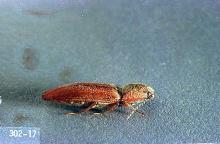Dryland wireworm (Ctenicera pruinina)
Pacific coast wireworm (Limonius canus)
Sugarbeet wireworm (Limonius californicus)
Pest description and crop damage Adults are hard-shelled, slender beetles called click beetles. They range in color from tan to very dark brown and are 0.3 to 0.5 inch in length. They appear in the spring and summer months. Larvae are the damaging stage. They are yellow-brown and up to 0.5 inch in length. Larvae have three pairs of legs. The last segment of the body is usually pronged or forked at the end. Larvae feed on the roots and into the crowns of plants, killing them or severely stunting growth.
Wireworm-damaged seedling stands often appear yellow, and plants eventually brown and die. Symptoms are apparent in the fall. Occasionally, summer-seeded grass seed is damaged before emergence, and there will be long lines of empty seed furrows.
Biology and life history Adult beetles appear in late spring through summer. Females lay many hundreds of eggs in both fallow and crop land. Eggs hatch in 3 to 4 weeks. Larvae usually infest non-irrigated grass seed land and can live in soil up to 3 years.
Sampling and thresholds Dig deeply to find wireworm larvae. They migrate readily up and down the soil profile. After 2 or 3 inches of rain have fallen in September and early October, wireworm larvae often can be found feeding within the root systems and lower crowns of grasses.
Management-chemical control
Effective soil-applied insecticides are not labeled for use on grasses grown. Preplant soil fumigation is used in high-value crops and suitable soils.
- azadirachtin/pyrethrin (Azera, Azera Pro) - Biological. See label rates as they vary for each product. REI 12 hr. PHI 0 days. Some products are OMRI listed for organic use.
- zeta-cypermethrin (Deadlock G) at 10 lb/A. Distribute granules evenly in the furrow at planting. Only one application is allowed per season. Maximum amount that can be applied is 10 lb/A per season. No rotation crops can be planted within 30 days of the last application. REI 12 hr.
For more information:
Pocket Guide to Grass Seed Pests and Beneficials: Identification, Monitoring, Management
https://extension.oregonstate.edu/catalog/pub/em9318





